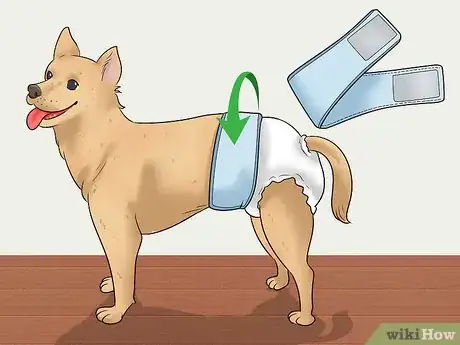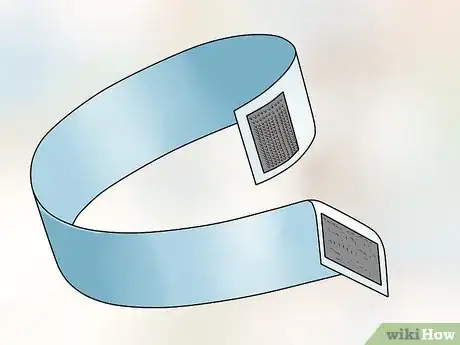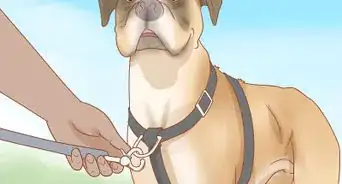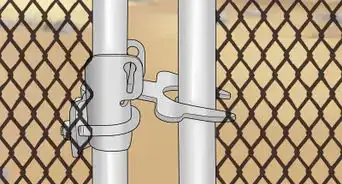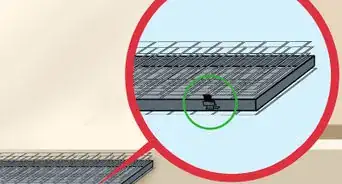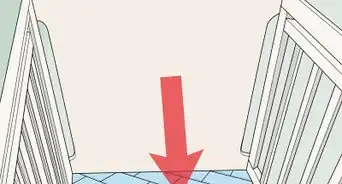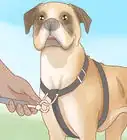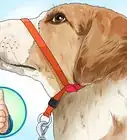This article was co-authored by Ryan Corrigan, LVT, VTS-EVN. Ryan Corrigan is a Licensed Veterinary Technician in California. She received her Bachelor of Science in Veterinary Technology from Purdue University in 2010. She is also a Member of the Academy of Equine Veterinary Nursing Technicians since 2011.
There are 7 references cited in this article, which can be found at the bottom of the page.
wikiHow marks an article as reader-approved once it receives enough positive feedback. In this case, 92% of readers who voted found the article helpful, earning it our reader-approved status.
This article has been viewed 75,114 times.
Dogs aren’t naturally comfortable wearing diapers, so they will often pull or scratch them off. However, there are many options available to help owners keep diapers on their dogs for more than a few minutes. A belly band is a creative solution that secures a diaper or pad against a dog’s body. You can also get a well-fitting diaper in the right size. Offering treats and praise during diaper changes is another way to convince your dog to leave its diaper alone.
Steps
Keeping the Diaper or Pad Secure
-
1Use a belly band for male dogs. A belly band is a thick fabric strap that wraps around your dog’s waist and is secured with Velcro at the ends. A sanitary pad is held onto your dog by the strap. These are most frequently used for male dogs to catch any sprayed urine. They will usually hold fast onto your dog unless they are very active.[1]
- The downside of belly bands is that they can easily shift around and leak urine, especially if the pad isn’t changed out regularly.
- The belly band must be placed high enough on a male dog’s waist, so that it effectively secures his penis and contains the urine stream.
-
2Attach canine suspenders to the diaper or band. Canine suspenders fit similar to a harness and attach around your dog’s torso with a combination of Velcro and buckles. Some suspenders slip directly onto the diaper and pull it tight, preventing it from slipping off. Other styles create a series of criss-cross straps with a spot to insert a sanitary pad.[2]
- You can also match the suspenders to your dog’s collar or other accessories. Most suspender sets cost between $15 to $30.
- Suspenders are usually a good choice for active dogs, as they will stay on despite jumping or playing.
Advertisement -
3Put a onesie over the diaper. If your dog is small enough, get a short-sleeved or no-sleeve baby onesie and put it on your dog. Then, place the diaper on your dog. Snap the onesie together at the back of your dog and this will hold your diaper against you.[3]
- To make this work you’ll need to cut a hole in the onesie for your dog’s tail.
-
4Secure a diaper or pad with modified underwear. You can also purchase a pair of small boy’s underwear in a size slightly smaller than your dog’s waist measurement. Cut out a spot for your dog’s tail and then use the underwear to hold a diaper or pad securely against your dog’s skin.
-
5Make your own attachment devices. It’s possible to make a homemade belly band or diaper belt by using an ace bandage with Velcro attached at the ends. You can either sew or glue Velcro onto the bandage. Another option is to buy elastic straps from a sewing store and use these on top of a diaper to hold it close to your dog.[4]
- If you decide to create a homemade strap, make sure that it is not too tight on your dog. Put it on your dog with a diaper and then see if you can comfortably fit one finger between the diaper and your dog’s skin.
-
6Buy reusable dog diapers. These diapers are made to be washed between uses, has a hole for the tail and fit specifically over their hips. You can find them in the pregnancy section at pet stores, but you can also be use them for incontinent males.
-
7Secure the diaper tabs with tape. If your dog keeps loosening the diaper tabs, then you may want to place a small piece of masking tape over the tabs to make the connection more secure and make it more difficult to move the diaper around. However, be careful that the tape adhesive is only on the diaper and does not come into contact with your dog’s skin or fur.[5]
Ensuring the Right Fit
-
1Measure your dog’s waist. Get a strip of paper and place it around the smallest part of your dog’s waist. Mark it and then measure that spot with a ruler. This is the waist number that you should use when selecting the right size diaper or band for your dog. If the diaper is too tight, it could hurt your dog. If it’s too big, it will likely fall off.[6]
- Many diapers only come in small, medium, and large sizes so look carefully at the size chart or see if you can pull it out of the box to check.
- As you take a measurement for a male dog, make sure to place your paper strip far enough forward to cover the dog’s penis and catch the urine.
- You can also use a fabric measuring tape to get your dog’s waist number.
-
2Consult the size guide. Diaper manufacturers follow varying size charts, so make sure to consult your brand’s before making a purchase. You’ll likely need to know your dog’s waist measurement as well as weight. When in doubt, go with a slightly larger size and use extra Velcro or a band to secure the diaper further.[7]
- For example, depending on the brand, a 15 pound dog will wear an extra small or small diaper.
-
3Try out several brands of diapers. There are many choices available to owners who want to help their dogs stay clean and comfortable. Depending on the size of your dog, you might want to consider infant diapers, adult incontinence pads, or even incontinence pants. If you are looking for a diaper with a high absorbency, a night diaper is usually a good choice.[8]
-
4Give plenty of room for the tail. If the diaper or pad pushes up against your dog’s tail, then they’ll likely scratch, pull, or wag it off. Most dog diapers come with a built in hole, just check that it is large enough. If you choose to use a human diaper or pad, then you’ll need to cut out a spot for the tail. Double check that it is large enough for your dog’s tail to move without restriction.
-
5Put baby diapers on backwards. If you decide to use human diapers, then they’ll fit better if you place the diaper so that the adhesive straps come together over your dog’s back. This reduces the possibility that your dog will be able to shake the diaper free while jumping or scratching.[9]
Making Your Dog Comfortable
-
1Look at the absorbency level of the diaper or pad. Some diapers are meant to take in large amounts of urine or feces, whereas others are best just for spotting. Before you decide on a brand or style, check to see how much liquid it is supposed to absorb. If the diaper gets soaked too quickly, it’s far more likely to fall off your dog.
-
2Protect any Velcro connections from damage. If the connectors on a diaper or band fail, then it will become loose and urine will leak out. To keep this from happening, make sure to fully attach your Velcro connections each time, pressing down a bit to make sure they are secure. Try not to expose the Velcro to moisture, aside from washing.[10]
-
3Change diapers at least every 3-4 hours. It’s best if you replace a diaper or pad as soon as it is soiled. Allowing urine or feces to sit against your dog’s skin can lead to infections and make it uncomfortable. If you suspect that your dog has soiled its band or suspenders, take those off and clean them as well.[11]
- Another reason to change your dog’s diapers is to keep them from scratching or pulling at it to relieve their discomfort.
-
4Use positive reinforcement. If your dog fights back or struggles every time you try to place a diaper on them, then this increases the likelihood that they’ll escape the diaper or band. Instead, make the diapering process positive by offering treats or kind words. Your dog will come to associate the diaper with rewards and they’ll be more likely to tolerate it.[12]
-
5Talk with your vet. If your dog keeps escaping from diapers, then make an appointment with your vet to discuss possible solutions. They’ll likely check out the skin around your dog’s privates, looking for signs of infection or redness. They might also order tests to rule out a urinary tract infection or other urinary-based ailments.[13]
Warnings
- Before you apply a cream or ointment under your dog’s diaper, talk with your vet. Some products, like zinc oxide, can poison your dog if they lick them.[15]⧼thumbs_response⧽
References
- ↑ http://www.humanesociety.org/animals/dogs/tips/housetraining_adult_dogs.html
- ↑ https://lessonsfromaparalyzeddog.com/taking-the-mystery-out-of-doggie-diapers/
- ↑ https://www.handicappedpets.com/pros-and-cons-of-pet-diapers-and-belly-bands
- ↑ https://lessonsfromaparalyzeddog.com/pet-parents-favorite-tips-to-keep-an-incontinent-dog-dry/
- ↑ https://pethelpful.com/dogs/Things-to-Consider-when-Buying-Dog-Diapers
- ↑ https://pethelpful.com/dogs/Things-to-Consider-when-Buying-Dog-Diapers
- ↑ https://pethelpful.com/dogs/Things-to-Consider-when-Buying-Dog-Diapers
- ↑ https://lessonsfromaparalyzeddog.com/pet-parents-favorite-tips-to-keep-an-incontinent-dog-dry/
- ↑ https://pethelpful.com/dogs/Things-to-Consider-when-Buying-Dog-Diapers
- ↑ http://www.dogchatforum.com/belly_bands_dog.htm
- ↑ https://lessonsfromaparalyzeddog.com/how-to-treat-and-prevent-urine-scald-in-paralyzed-dogs/
- ↑ https://pethelpful.com/dogs/Things-to-Consider-when-Buying-Dog-Diapers
- ↑ https://lessonsfromaparalyzeddog.com/pet-parents-favorite-tips-to-keep-an-incontinent-dog-dry/
- ↑ https://pethelpful.com/dogs/Things-to-Consider-when-Buying-Dog-Diapers
- ↑ https://www.handicappedpets.com/pros-and-cons-of-pet-diapers-and-belly-bands
About This Article
If your dog tries pulling or scratching off its diaper, there are a few products you can use to help keep the diaper in place. Try attaching canine suspenders to the diaper so it won’t slip off. If your dog is small, get a short-sleeved baby onesie to put over the diaper so your dog won’t mess with it. Another option is to buy a pair of boy’s underwear in a size slightly smaller than your dog’s waist and put them on over the diaper to help secure it in place. For male dogs, use a belly band, which is a thick fabric strap that wraps around your dog’s waist and holds a sanitary pad in place. For more tips from our Veterinary co-author, including how to ensure your dog’s diaper fits properly, keep reading!
